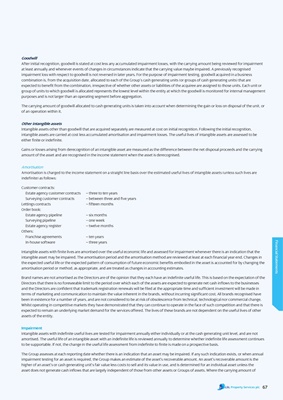
goodwill
After initial recognition, goodwill is stated at cost less any accumulated impairment losses, with the carrying amount being reviewed for impairment
at least annually and whenever events of changes in circumstances indicate that the carrying value maybe impaired. A previously recognised
impairment loss with respect to goodwill is not reversed in later years. For the purpose of impairment testing, goodwill acquired in a business
combination is, from the acquisition date, allocated to each of the Group’s cash generating units (or groups of cash generating units) that are
expected to benefit from the combination, irrespective of whether other assets or liabilities of the acquiree are assigned to those units. Each unit or
group of units to which goodwill is allocated represents the lowest level within the entity at which the goodwill is monitored for internal management
purposes and is not larger than an operating segment before aggregation.
The carrying amount of goodwill allocated to cash generating units is taken into account when determining the gain or loss on disposal of the unit, or
of an operation within it.
other intangible assets
Intangible assets other than goodwill that are acquired separately are measured at cost on initial recognition. Following the initial recognition,
intangible assets are carried at cost less accumulated amortisation and impairment losses. The useful lives of intangible assets are assessed to be
either finite or indefinite.
Gains or losses arising from derecognition of an intangible asset are measured as the difference between the net disposal proceeds and the carrying
amount of the asset and are recognised in the income statement when the asset is derecognised.
Amortisation
Amortisation is charged to the income statement on a straight line basis over the estimated useful lives of intangible assets (unless such lives are
indefinite) as follows:
Customer contracts:
Estate agency customer contracts – three to ten years
Surveying customer contracts – between three and five years
Lettings contracts – fifteen months
Order book:
Estate agency pipeline – six months
Surveying pipeline – one week
Estate agency register – twelve months
Others:
Franchise agreements – ten years
Financial Statements
In-house software – three years
Intangible assets with finite lives are amortised over the useful economic life and assessed for impairment whenever there is an indication that the
intangible asset may be impaired. The amortisation period and the amortisation method are reviewed at least at each financial year end. Changes in
the expected useful life or the expected pattern of consumption of future economic benefits embodied in the asset is accounted for by changing the
amortisation period or method, as appropriate, and are treated as changes in accounting estimates.
Brand names are not amortised as the Directors are of the opinion that they each have an indefinite useful life. This is based on the expectation of the
Directors that there is no foreseeable limit to the period over which each of the assets are expected to generate net cash inflows to the businesses
and the Directors are confident that trademark registration renewals will be filed at the appropriate time and sufficient investment will be made in
terms of marketing and communication to maintain the value inherent in the brands, without incurring significant cost. All brands recognised have
been in existence for a number of years, and are not considered to be at risk of obsolescence from technical, technological nor commercial change.
Whilst operating in competitive markets they have demonstrated that they can continue to operate in the face of such competition and that there is
expected to remain an underlying market demand for the services offered. The lives of these brands are not dependent on the useful lives of other
assets of the entity.
impairment
Intangible assets with indefinite useful lives are tested for impairment annually either individually or at the cash generating unit level, and are not
amortised. The useful life of an intangible asset with an indefinite life is reviewed annually to determine whether indefinite life assessment continues
to be supportable. If not, the change in the useful life assessment from indefinite to finite is made on a prospective basis.
The Group assesses at each reporting date whether there is an indication that an asset may be impaired. If any such indication exists, or when annual
impairment testing for an asset is required, the Group makes an estimate of the asset’s recoverable amount. An asset’s recoverable amount is the
higher of an asset’s or cash generating unit’s fair value less costs to sell and its value in use, and is determined for an individual asset unless the
asset does not generate cash inflows that are largely independent of those from other assets or Groups of assets. Where the carrying amount of
67